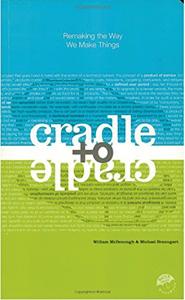
Want to learn the ideas in Cradle To Cradle better than ever? Read the world’s #1 book summary of Cradle To Cradle by Michael Braungart, William McDonough here.
Read a brief 1-Page Summary or watch video summaries curated by our expert team. Note: this book guide is not affiliated with or endorsed by the publisher or author, and we always encourage you to purchase and read the full book.
Video Summaries of Cradle To Cradle
We’ve scoured the Internet for the very best videos on Cradle To Cradle, from high-quality videos summaries to interviews or commentary by Michael Braungart, William McDonough.
1-Page Summary of Cradle To Cradle
Overall Summary
Cradle to Cradle is a book that urges us to rethink our manufacturing and industrial systems, which are damaging the environment. The authors also discuss environmentalism and design, urging readers to think about what it means to be “eco-friendly” in today’s world.
William McDonough is an American architect and Michael Braungart is a German chemist. They have created a new way of thinking about how to improve manufacturing practices that focuses on the environment instead of just making things better for the environment. The authors reject recycling, which they call “eco-efficiency,” in favor of their own model called “eco-effectiveness.” They also debunk popular notions about how industry interacts with the environment and shows that it’s not necessary to create products that are only good for the environment. Instead, manufacturers should design products from scratch so they can be reused or recycled into other products when they’re no longer useful.
Cradle to Cradle is a book that has six chapters. The first chapter, Introduction, introduces the reader to the authors and their business called McDonough Braungart Design Chemistry. They have transformed industry by turning chemical research into architecture and industrial product design with the goal of transforming industry itself.
Chapter 1 of the book discusses how industrialization has had devastating effects on our environment. It was during that time that businesses started to view waste as a necessary byproduct, and they began dumping it in landfills. The Industrial Revolution also introduced the idea of one-size-fits-all design, and brute force became an acceptable means for achieving goals. Chapter 2 explains why environmentalism alone is not enough to solve the problem; we need an eco-effective model instead. In this new model, industry must be beneficial to our environment like a tree or any other organism in nature.
Chapter 3 introduces their proposed eco-effectiveness model which will replace “eco” or green efficiency because it’s just about making things less bad for the environment without actively trying to make them better.
Chapter 4 explains what a nutrient flow is and how it can be used to create eco-effectiveness. Chapter 5 discusses the importance of diversity in manufacturing, which supports their design strategy. In chapter 6, they provide practical suggestions for implementing this strategy at both an individual and corporate level.
The primary message in Cradle to Cradle is that a radical change needs to be made. Western society’s approach towards industrialism and environmentalism must be completely overhauled. The authors explain this message in simple terms through their book, which was published on synthetic paper, which they claim is completely safe for the environment and cost-efficient for the publishing industry. This shows that it’s not impossible to make these radical changes because of how they’ve done so with their own book.
Introduction: “This Book is Not a Tree”
The book begins with a domestic scene, in which the reader is invited to relax and read while their daughter uses a computer. The baby crawls on the floor, playing with colorful plastic toys. It certainly feels as if all is well. However, this idyllic setting belies how toxic many of the products surrounding us are. For example, computers contain more than 1,000 different kinds of materials that can be harmful to humans and animals; some even contain lead or mercury. As such, we need to rethink our current manufacturing processes so that they’re better for people and for the environment.





